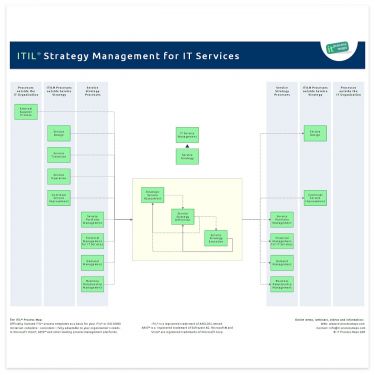ITIL Strategy Management
<seo metakeywords="itil strategy management, strategy management itil, strategy management for it services" metadescription="Strategy Management for IT Services: ITIL process definition - Sub-processes - Terms - Additional information on Strategy Management." />

Overview
Objective: The objective of Strategy Management for IT Services is to assess the service provider’s offerings, capabilities, competitors as well as current and potential market spaces in order to develop a strategy to serve customers. Once the strategy has been defined, ITIL Strategy Management is also responsible for ensuring the implementation of the strategy.
Part of: Service Strategy
Process Owner: Service Strategy Manager
Process Description

In the ITIL 2007 edition, strategic assessments and the development of the service strategy were performed under Service Portfolio Management.
ITIL 2011 has introduced a clearly defined set of strategic processes, including "Service Management for IT Services". The process overview of ITIL Strategy Management (.JPG) is showing the most important interfaces (see Figure 1).
Furthermore the new ITIL role Service Strategy Manager has been introduced to support the IT Steering Group.
Sub-Processes
These are the Strategy Management for IT Services sub-processes and their process objectives:
- Strategic Service Assessment
- Process Objective: To assess the present situation of the service provider within its current market spaces. This includes an assessment of current service offerings, customer needs and competing offers from other service providers.
- Service Strategy Definition
- Process Objective: To define the overall goals the service provider should pursue in its development, and to identify what services will be offered to what customers or customer segments, based on the results of the Strategic Service Assessment.
- Service Strategy Execution
- Process Objective: To define and plan strategic initiatives, and ensure the implementation of those initiatives.
Definitions
The following ITIL terms and acronyms (information objects) are used in Strategy Management for IT Services to represent process outputs and inputs:
- Business Planning Information
- Business Planning Information includes important input from clients and external service providers, especially for devising the Service Strategy and looking for ways to improve services. This input will highlight, for example, planned business initiatives like the introduction of new product/ service offerings or the expansion into new markets, as well as information on the future development of business activity, especially expected increases in business transaction volumes. This information helps the service organization understand the businesses it serves and their plans for the future, allowing it to offer and develop the right set of services.
- Service Strategy
- A systematic long-term plan of action, designed by the IT Service Organization to achieve defined objectives.
- Strategic Plan
- A plan for implementing the Service Strategy, containing specific objectives, activities and responsibilities.
- Strategic Service Assessment
- The Strategic Service Assessment is used to gain insight into a service provider's weaknesses and strengths prior to developing a Service Strategy.
Checklists | KPIs
Roles | Responsibilities
- Service Strategy Manager - Process Owner
- The Service Strategy Manager supports the IT Steering Group in producing and maintaining the service provider's strategy. This role is also responsible for communicating and implementing the service strategy.
- IT Steering Group (ISG)
- The IT Steering Group (ISG) sets the direction and strategy for IT Services. It includes members of senior management from business and IT. The IT Steering Group reviews the business and IT strategies in order to make sure that they are aligned. It also sets priorities of service development programs/ projects.
| Responsibility Matrix: ITIL Strategy Management | ||
| ITIL Role | Sub-Process | Service Strategy Manager | IT Steering Group |
|---|---|---|
| Strategic Service Assessment | A[1]R[2] | R |
| Service Strategy Definition | AR | R |
| Service Strategy Execution | AR | R |
Remarks
[1] A: Accountable according to the RACI Model: Those who are ultimately accountable for the correct and thorough completion of the ITIL Strategy Management process.
[2] R: Responsible according to the RACI Model: Those who do the work to achieve a task within Strategy Management for IT Services.






